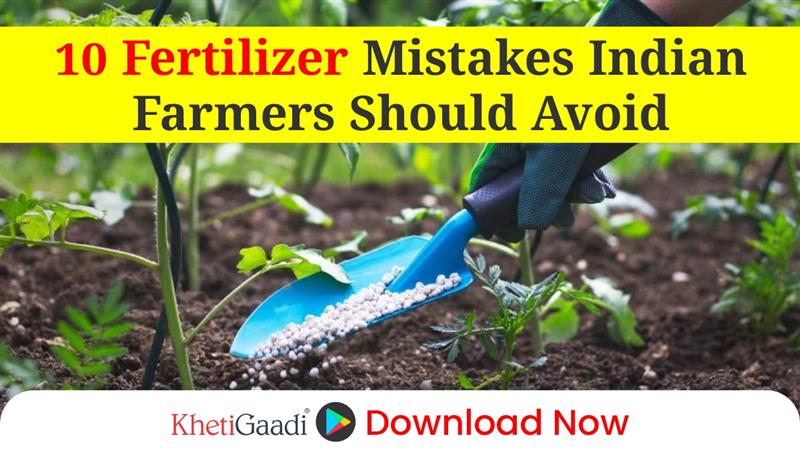Fertilisers in India
Proper fertilizer application is crucial in agriculture to ensure optimal crop growth, yield, and soil health. However, incorrect usage of fertilizers can harm crops, deplete soil fertility, and negatively impact the environment. Here, we explore common mistakes farmers in India should avoid when using fertilizers to maximize productivity and reduce risks.
1. Using the Wrong Type of Fertilizer
Fertilizers come in many forms, including organic and inorganic, with each suited to specific crop and soil requirements. Understanding the differences and appropriate applications is crucial:
- Organic Fertilizers: Derived from natural sources such as manure, compost, and bone meal. They improve soil structure and provide long-term fertility.
- Chemical Fertilizers: Typically faster-acting and high in essential nutrients like nitrogen, phosphorus, and potassium (NPK). However, excessive use can lead to soil degradation.
Before applying fertilizers, farmers should assess their soil type, crop, and environmental conditions to choose the right fertilizer. Misuse can result in nutrient imbalances and increased input costs.
2. Ignoring Soil Testing
A significant mistake is applying fertilizers without conducting a soil test. Soil testing provides valuable information about soil pH, nutrient levels, and deficiencies. By understanding what the soil lacks, farmers can apply only the necessary nutrients.
- How to Conduct Soil Testing: Many government and private agencies offer soil testing services. The Soil Health Card Scheme by the Indian government provides farmers with soil health data and recommendations for balanced fertilizer application.
Ignoring soil testing can lead to nutrient imbalance, poor crop health, and wasteful spending on unnecessary fertilizers.
3. Overusing Chemical Fertilizers
Excessive use of chemical fertilizers is a widespread issue that can harm the soil, water sources, and crops themselves. When chemical fertilizers are overused, soil salinity and acidity can increase, resulting in reduced fertility over time.
Nitrogen Overload: Urea and other nitrogen-based fertilizers should be applied carefully. Excess nitrogen can lead to lush foliage growth at the expense of fruit or grain production and can also increase pest infestation.
Applying only the recommended quantities as per soil test results and adhering to best practices helps avoid these issues.
4. Ignoring Fertilizer Timing and Crop Growth Stages
Timing of fertilizer application is as important as the type and quantity. Different growth stages require different nutrient levels:
- Early Growth: Nitrogen is crucial for young plants, encouraging leafy growth.
- Flowering and Fruiting Stages: Phosphorus and potassium support flowering, fruiting, and root development.
Farmers should avoid applying fertilizers at the wrong stages, as this may result in lower yield, nutrient wastage, and unnecessary costs.
5. Applying Fertilizer Incorrectly
Proper application techniques can make a significant difference in fertilizer effectiveness. Surface broadcasting, for instance, can result in nutrient loss through runoff, while deep placement or banding can help nutrients reach the root zone more effectively.
- Drip Fertigation: Using drip irrigation systems to apply water-soluble fertilizers allows plants to absorb nutrients directly, reducing wastage and improving efficiency.
- Split Applications: Splitting fertilizer applications over time allows plants to receive nutrients when they need them most, rather than all at once.
By adopting appropriate methods, farmers can increase nutrient uptake and reduce losses.
6. Not Considering the Weather Conditions
Applying fertilizers in the wrong weather conditions can lead to wastage and environmental damage. Rain can wash away surface-applied fertilizers, while high temperatures can cause volatilization of certain nutrients, reducing their effectiveness.
- Avoid Rainy Days: Rain can wash away nitrogen and other nutrients before they penetrate the soil, leading to waste and potential water pollution.
- Temperature and Wind: Applying fertilizers during calm, cool conditions helps to prevent nutrient losses through volatilization and wind drift.
Checking weather forecasts and scheduling fertilizer applications accordingly will help in efficient fertilizer use.
7. Neglecting Micronutrient Needs
Farmers often focus on primary nutrients (NPK) and ignore micronutrients like zinc, boron, and iron, which are equally essential for plant health and productivity. Micronutrient deficiencies can lead to poor crop growth and low yield.
- Zinc Deficiency: Zinc is crucial for crop growth in India, and zinc-deficient soils are common.
- Boron and Iron: These elements support flowering and chlorophyll production. Regular soil testing can identify deficiencies and help apply micronutrients only when needed.
Applying a balanced mix of macro and micronutrients can significantly improve crop yields.
8. Using Banned or Restricted Fertilizers
Several fertilizers are banned or restricted in India due to their harmful effects on soil health and the environment. Using such products not only risks crop health but also violates regulations, which could lead to fines.
Check the List of Banned Fertilizers: The Central Fertilizer Control Laboratory (CFCL) provides an updated list of restricted fertilizers. Farmers should regularly check for any updates to ensure compliance.
Ensuring that only approved fertilizers are used will prevent legal issues and support sustainable farming practices.
The Indian government regulates fertilizers to ensure environmental safety and prevent soil degradation. Below is a list of banned or restricted fertilizers in India, as updated by the Central Fertilizer Control Laboratory (CFCL). Farmers are advised to stay updated on these restrictions to avoid using products that are harmful to crops and soil health.
List of Banned or Restricted Fertilizers in India
- Ammonium Nitrate: Restricted due to its explosive nature and potential misuse.
- Calcium Cyanide: Banned due to its toxicity and environmental impact.
- Ammonium Sulphate Nitrate: Banned due to environmental hazards associated with its application.
- Nitrogen-Phosphorus Potassium (NPK) Fertilizers with Harmful Ratios: Some NPK ratios are restricted based on high nitrogen content that can cause soil degradation.
- Potassium Chloride (High Concentration): Restricted in certain areas where potassium content is naturally high to avoid nutrient imbalance.
- Single Super Phosphate (Low-Grade): Some low-quality SSP fertilizers are restricted due to their high impurity content.
- Chloropicrin: Banned as it is toxic and can lead to soil contamination.
- Methyl Bromide: Banned for being hazardous to the ozone layer and harmful to soil organisms.
- Sodium Nitrate: Restricted due to concerns over soil alkalinity.
- Zinc Phosphide: Primarily used as a rodenticide and restricted in fertilizer use due to potential crop toxicity.
These restrictions are periodically updated by the Ministry of Agriculture and Farmers’ Welfare. Farmers are advised to check the Central Fertilizer Control Laboratory (CFCL) website for the latest updates: CFCL Official Website.
9. Ignoring Organic Alternatives
Organic fertilizers improve soil health and fertility over the long term, yet many farmers still rely solely on chemical options. Incorporating organic fertilizers such as compost, green manure, and vermicompost can enhance the soil’s structure and water-holding capacity.
- Benefits of Organic Fertilizers: Organic inputs release nutrients slowly, supporting sustained crop growth. They also increase microbial activity, enhancing soil fertility.
Farmers should combine organic and chemical fertilizers for better soil health and sustainable yields.
10. Not Using Government Subsidies and Schemes
The Indian government offers various schemes and subsidies to help farmers access fertilizers at reduced costs. Farmers can reduce production costs and optimize fertilizer use by taking advantage of these programs.
- Subsidies: Nutrient Based Subsidy (NBS) for chemical fertilizers and subsidies on organic inputs make fertilizers more affordable.
- Kisan Credit Card (KCC): Provides credit for purchasing fertilizers and other inputs.
Farmers should stay informed about current schemes to reduce fertilizer costs and increase profitability.
Relevant Links and Resources
- Soil Health Card Scheme: https://soilhealth.dac.gov.in
- Nutrient Based Subsidy (NBS) Scheme: https://fert.nic.in
- Central Fertilizer Control Laboratory (CFCL): Updated list of banned fertilizers.
https://fert.nic.in/fertilizer-quality-control - Kisan Credit Card (KCC): https://www.pmkisan.gov.in
- Indian Council of Agricultural Research (ICAR): Research articles and fertilizer guidelines.
https://icar.org.in
Tags




